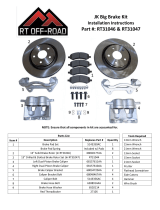
7
TO ENSURE SAFETY
NOTICE
Be sure to also inform users of the following:
•
Be sure to keep turning the crank during the gear shifting.
•
Handle the products carefully, and avoid subjecting them to any strong shocks.
•
Do not use thinners or similar substances to clean the products. Such substances may damage the surfaces.
•
In the case of carbon levers, wash them with a soft cloth using a neutral detergent. Otherwise, the material may get damaged, and the strength may
be affected.
•
Avoid leaving the carbon levers in places where high temperatures are present. Also, keep them far away from fire.
•
If gear shifting operations do not feel smooth, wash the derailleur and lubricate all moving parts.
•
When the bicycle wheel has been removed, it is recommended that pad spacers are installed. Do not depress the brake lever while the wheel is
removed. If the brake lever is depressed without the pad spacers installed, the pistons will protrude further than normal. If that happens, consult a
dealer.
•
Use soapy water and a dry cloth when cleaning and carrying out maintenance of the brake system. Do not use commercially available brake cleaners
or silencing agents, as they can cause damage to parts such as seals.
•
Products are not guaranteed against natural wear and deterioration from normal use and aging.
•
For maximum performance we highly recommend Shimano lubricants and maintenance products.
For Installation to the Bicycle, and Maintenance:
•
Use a brake hose / outer casing which still has some length to spare even when the handlebars are turned all the way to both sides. Furthermore,
check that the shifting lever does not touch the bicycle frame when the handlebars are turned all the way.
•
Use an OT-SP cable and cable guide for smooth operation.
•
Grease the inner cable and the inside of the outer casing before use to ensure that they slide properly. Do not let dust adhere on the inner cable. If
the grease on the inner cable is wiped off, the application of SIS SP41 grease (Y04180000) is recommended.
•
A special grease is used for the gear shifting cable. Do not use Premium Grease or other types of grease, otherwise they may cause deterioration in
gear shifting performance.
•
If gear shifting adjustments cannot be carried out, check that the rear dropouts are aligned. Also check if the cable is lubricated and if the outer casing
is too long or too short.
•
Do not remove the lever unit.
Disc brake
•
If the brake caliper mounting boss and the dropout are not of standard dimensions, the disc brake rotor and caliper may touch.
•
When the bicycle wheel has been removed, it is recommended that pad spacers are installed. The pad spacers will prevent the piston from coming out
if the brake lever is depressed while the wheel is removed.
•
If the brake lever is depressed without the pad spacers installed, the pistons will protrude further than is normal. Use a slotted screwdriver or similar
tool to push back the brake pads, while being careful not to damage the surfaces of the brake pads. (If the brake pads are not installed, use a
flat-shaped tool to push the pistons straight back in, while being careful not to damage them)
If it is difficult to push the brake pads or pistons back, remove the bleed screws and then try again. (Note that some oil may overflow from the
reservoir tank at this time.)
•
Use isopropyl alcohol, soapy water or a dry cloth when cleaning and carrying out maintenance of the brake system. Do not use commercially available
brake cleaners or silencing agents. They can cause damage to parts such as seals.
•
Do not remove the pistons when disassembling the brake calipers.
•
If the disc brake rotor is worn, cracked or warped, it should be replaced.
•
The clamp band, clamp bolt, and clamp nut are not compatible with other products. Do not use with components that are used in other products.
The actual product may differ from the illustration because this manual is intended chiefly to explain the procedures for using
the product.





















